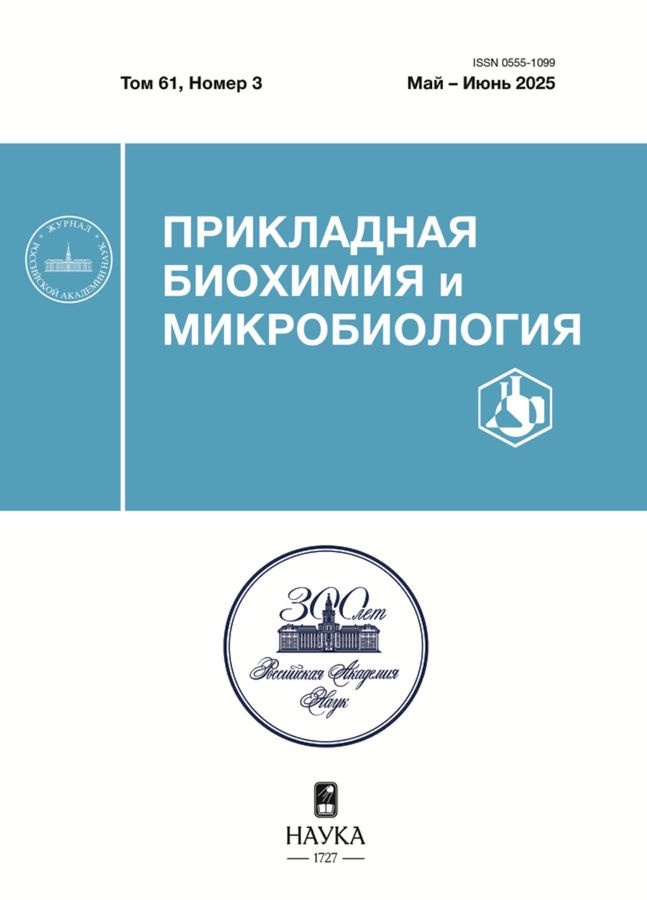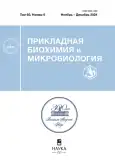Филогенетический состав микробных сообществ обрастаний титановых пластин в прибрежной зоне Черного и Белого морей
- Авторы: Брюханов А.Л.1, Шутова А.С.2, Комарова К.А.2, Семенова Т.А.2, Семенов А.А.1, Карпов В.А.2
-
Учреждения:
- Московский государственный университет имени М.В. Ломоносова
- Институт проблем экологии и эволюции имени А.Н. Северцова РАН
- Выпуск: Том 60, № 6 (2024)
- Страницы: 602-609
- Раздел: Статьи
- URL: https://gynecology.orscience.ru/0555-1099/article/view/681117
- DOI: https://doi.org/10.31857/S0555109924060046
- EDN: https://elibrary.ru/QGSFYS
- ID: 681117
Цитировать
Полный текст
Аннотация
С помощью высокопроизводительного секвенирования вариабельного региона V3–V4 гена 16S рРНК исследован полный филогенетический состав микробных сообществ, развивающихся на поверхности титановых пластин в водной толще прибрежной зоны Черного и Белого морей. Показано наличие в этих обрастаниях потенциально коррозионно-активных микроорганизмов различных физиологических групп, таких, как сульфатредуцирующие бактерии, ацидофильные железоокисляющие бактерии и археи, сероокисляющие и нитрифицирующие бактерии. В обрастаниях титановых пластин, экспонированных в Черном море, наиболее распространенными микроорганизмами оказались некультивируемые сульфатредуцирующие бактерии порядка Desulfotomaculales, на которых приходилось 8.13% от всех прочтений последовательностей гена 16S рРНК, а также ацидофильные железоокисляющие бактерии родов Acidiferrobacter (5.47%), Acidithiobacillus (4.52%) и Acidiphilium (2.55%). Ацидофильные археи составляли вплоть до 7.97% от всех прочтений. В обрастаниях титановых пластин, экспонированых в Белом море, наиболее распространенными также оказались ацидофильные бактерии из порядков Acidiferrobacterales и Acidithiobacillales (7.68%), а также ацидофильные археи из порядка Thermoplasmatales (7.43%). В относительно большом количестве были представлены и некультивируемые сульфатредуцирующие бактерии порядка Desulfotomaculales (6.61%).
Полный текст
Об авторах
А. Л. Брюханов
Московский государственный университет имени М.В. Ломоносова
Автор, ответственный за переписку.
Email: tashino@mail.ru
биологический факультет
Россия, Москва, 119234А. С. Шутова
Институт проблем экологии и эволюции имени А.Н. Северцова РАН
Email: tashino@mail.ru
Россия, Москва, 119071
К. А. Комарова
Институт проблем экологии и эволюции имени А.Н. Северцова РАН
Email: tashino@mail.ru
Россия, Москва, 119071
Т. А. Семенова
Институт проблем экологии и эволюции имени А.Н. Северцова РАН
Email: tashino@mail.ru
Россия, Москва, 119071
А. А. Семенов
Московский государственный университет имени М.В. Ломоносова
Email: tashino@mail.ru
биологический факультет
Россия, Москва, 119234В. А. Карпов
Институт проблем экологии и эволюции имени А.Н. Северцова РАН
Email: tashino@mail.ru
Россия, Москва, 119071
Список литературы
- Enning D., Garrelfs J. // Appl. Environ. Microbiol. 2014. V. 80. № 4. P. 1226–1236. https://doi.org/10.1128/AEM.02848-13
- Tsarovtceva I.M., Bryukhanov A.L., Vlasov D.Y., Maiyorova M.A. // Power Technol. Eng. 2023. V. 57. № 2. P. 203–208. https://doi.org/10.1007/s10749-023-01643-4
- Vlasov D.Y., Bryukhanov A.L., Nyanikova G.G., Zelenskaya M.S., Tsarovtseva I.M., Izatulina A.R. // Appl. Biochem. Microbiol. 2023. V. 59. № 4. P. 425–437. https://doi.org/10.1134/S0003683823040166
- Emerson D. // Biofouling. 2018. V. 34. № 9. P. 989–1000. https://doi.org/10.1080/08927014.2018.1526281
- Zhang Y., Griffin A., Edwards M. // Environ. Sci. Technol. 2008. V. 42. № 12. P. 4280–4284. https://doi.org/10.1021/es702483d
- Magoč T., Salzberg S.L. // Bioinformatics. 2011. V. 27. № 21. P. 2957–2963. https://doi.org/10.1093/bioinformatics/btr507
- Edgar R.C. // Bioinformatics. 2010. V. 26. № 19. P. 2460–2461. https://doi.org/10.1093/bioinformatics/btq461
- Wang Q., Garrity G.M., Tiedje J.M., Cole J.R. // Appl. Environ. Microbiol. 2007. V. 73. № 16. P. 5261–5267. https://doi.org/10.1128/AEM.00062-07
- Liu H., Meng G, Li W., Gu T., Liu H. // Front. Microbiol. 2019. V. 10. P. 1298. https://doi.org/10.3389/fmicb.2019.01298
- Barton L.L., Hamilton W.A. In: Sulphate-reducing Bacteria: Environmental and Engineered Systems. / Ed. L.L. Barton, W.A. Hamilton. Cambridge: Cambridge University Press, 2007. 533 p.
- Hallberg K.B., Hedrich S., Johnson D.B. // Extremophiles. 2011. V. 15. № 2. P. 271–279. https://doi.org/10.1007/s00792-011-0359-2
- Williams K.P., Kelly D.P. // Int. J. Syst. Evol. Microbiol. 2013. V. 63. № 8. P. 2901–2906. https://doi.org/10.1099/ijs.0.049270-0
- Jones D.S., Albrecht H.L., Dawson K.S., Schaperdoth I., Freeman K.H., Pi Y., Pearson A., Macalady J.L. // ISME J. 2012. V. 6. № 1. P. 158–170. https://doi.org/10.1038/ismej.2011.75
- Gadd G.M. // Geoderma. 2004. V. 122. № 2–4. P. 109–119. https://doi.org/10.1016/j.geoderma.2004.01.002
- Li X., Kappler U., Jiang G., Bond P.L. // Front. Microbiol. 2017. V. 8. P. 683. https://doi.org/10.3389/fmicb.2017.00683
- Magnuson T.S., Swenson M.W., Paszczynski A.J., Deobald L.A., Kerk D., Cummings D.E. // Biometals. 2010. V. 23. № 6. P. 1129–1138. https://doi.org/10.1007/s10534-010-9360-y
- Dopson M., Baker-Austin C., Hind A., Bowman J.P., Bond P.L. // Appl. Environ. Microbiol. 2004. V. 70. № 4. P. 2079–2088. https://doi.org/10.1128/AEM.70.4.2079-2088.2004
- Golyshina O.V. // Appl. Environ. Microbiol. 2011. V. 77. № 15. P. 5071–5078. https://doi.org/10.1128/AEM.00726-11
- Zhang L., Wu J., Wang Y., Wan L., Mao F., Zhang W., Chen X., Zhou H. // Hydrometallurgy. 2014. V. 146. P. 15–23. https://doi.org/10.1016/j.hydromet.2014.02.013
- Golyshina O.V., Yakimov M.M., Lünsdorf H., Ferrer M., Nimtz M., Timmis K.N., et al. // Int. J. Syst. Evol. Microbiol. 2009. V. 59. № 11. P. 2815–2823. https://doi.org/10.1099/ijs.0.009639-0
- Ojumu T.V., Petersen J. // Hydrometallurgy. 2011. V. 106. № 1–2. P. 5–11. https://doi.org/10.1016/j.hydromet.2010.11.007
- Doughari H.J., Ndakidemi P.A., Human I.S., Benade S. // Microbes Environ. 2011. V. 26. № 2. P. 101–112. https://doi.org/10.1264/jsme2.ME10179
- Alain K., Pignet P., Zbinden M., Quillevere M., Duchiron F., Donval J.P., et al. // Int. J. Syst. Evol. Microbiol. 2002. V. 52. № 5. P. 1621–1628. https://doi.org/10.1099/00207713-52-5-1621
- Dahle H., Birkeland N.K. // Int. J. Syst. Evol. Microbiol. 2006. V. 56. № 7. P. 1539–1545. https://doi.org/10.1099/ijs.0.63894-0
- Yu J., Liberton M., Cliften P.F., Head R.D., Jacobs J.M., Smith R.D., et al. // Sci. Rep. 2015. V. 5. P. 8132. https://doi.org/10.1038/srep08132
- Liu X.J., Zhu K.L., Ye Y.Q., Han Z.T., Tan X.Y., Du Z.J., Ye M.Q. // Microb. Genom. 2024. V. 10. № 1. P. 001182. https://doi.org/10.1099/mgen.0.001182
- Simankova M.V., Chernych N.A., Osipov G.A., Zavarzin G.A. // Syst. Appl. Microbiol. 1993. V. 16. № 3. P. 385–389. https://doi.org/10.1016/S0723-2020(11)80270-5
- Hördt A., López M.G., Meier-Kolthoff J.P., Schleuning M., Weinhold L.M., Tindall B.J., et al. // Front. Microbiol. 2020. V. 11. P. 468. https://doi.org/10.3389/fmicb.2020.00468
- Doerfert S.N., Reichlen M., Iyer P., Wang M., Ferry J.G. // Int. J. Syst. Evol. Microbiol. 2009. V. 59. № 5. P. 1064–1069. https://doi.org/10.1099/ijs.0.003772-0
- Shih C.J., Lai M.C. // Can. J. Microbiol. 2010. V. 56. № 4. P. 295–307. https://doi.org/10.1139/W10-008
- Cheng L., Qiu T.L., Yin X.B., Wu X.L., Hu G.Q., Deng Y., Zhang H. // Int. J. Syst. Evol. Microbiol. 2007. V. 57. № 12. P. 2964–2969. https://doi.org/10.1099/ijs.0.65049-0
- Bryukhanov A.L., Vlasov D.Y., Maiorova M.A., Tsarovtseva I.M. // Power Technol. Eng. 2021. V. 54. № 5. P. 609–614. https://doi.org/10.1007/s10749-020-01260-5
Дополнительные файлы










